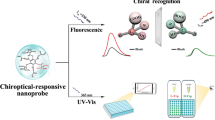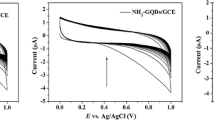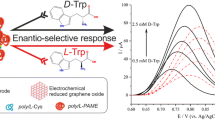Abstract
Chirality is a fundamental phenomenon of nature, and the enantioselective recognition of amino acids isomers is especially important for life science. In this study, chiroptical system based on chiral assembly graphene quantum dots (GQDs) was developed for visual testing of D-phenylalanine (D-Phe). Here, GQDs were used as the fluorescent element, and chiral functional moieties of 1,3,5-triformylphloroglucinol-functionalized chiral ( +)-diacetyl-L-tartaric anhydride (TPTA) were used as the chiral recognition elements. Based on the formed chiral microenvironment, the fluorescence intensity of TPTA-assembled GQDs had a good linear relationship with D-Phe in the concentration range of 0.1–5 μM, and the detection limit was 0.023 μM. According to the variation in luminance of TPTA-assembled GQDs, visual testing to D-Phe was realized using a smartphone-assisted chiroptical system with a detection limit of 0.050 μM. The spiked recoveries of both chiroptical sensing methods based on TPTA-assembled GQDs from the food matrix ranged from 86.20 to 110.0%. Furthermore, TPTA-assembled GQDs were successfully applied to intracellular chiroptical imaging in response to D-Phe in vitro. The developed chiral nanomaterial TPTA-assembled GQDs with excellent photochemical stability, optical properties, and bioimaging capabilities provide a promising technique for the visual detection of amino acid isomers in the field of smart devices.
Graphical abstract







Similar content being viewed by others
References
Li L, Wu G, Yang G, Peng J, Zhao J, Zhu J. Focusing on luminescent graphene quantum dots: current status and future perspectives. Nanoscale. 2013;5(10):4015–39. https://doi.org/10.1039/C3NR33849E.
Wang X, Sun G, Li N, Chen P. Quantum dots derived from two-dimensional materials and their applications for catalysis and energy. Chem Soc Rev. 2016;45(8):2239–62. https://doi.org/10.1039/C5CS00811E.
Libisch F, Stampfer C, Burgdörfer J. Graphene quantum dots: beyond a Dirac billiard. Phys Rev B. 2009;79(11):115423. https://doi.org/10.1103/PhysRevB.79.115423.
Lin L, Rong M, Luo F, Chen D, Wang Y, Chen X. Luminescent graphene quantum dots as new fluorescent materials for environmental and biological applications. Trends Analyt Chem. 2014;54:83–102. https://doi.org/10.1016/j.trac.2013.11.001.
Kamal Z, Zarei Ghobadi M, Mohseni SM, Ghourchian H. High-performance porphyrin-like graphene quantum dots for immuno-sensing of Salmonella typhi. Biosens Bioelectron. 2021;188:113334. https://doi.org/10.1016/j.bios.2021.113334.
Loh KP, Bao Q, Eda G, Chhowalla M. Graphene oxide as a chemically tunable platform for optical applications. Nat Chem. 2010;2(12):1015–24. https://doi.org/10.1038/nchem.907.
Yan X, Cui X, Li B, Li L. Large, solution-processable graphene quantum dots as light absorbers for photovoltaics. Nano Lett. 2010;10(5):1869–73. https://doi.org/10.1021/nl101060h.
Zhao B, Yang S, Deng J, Pan K. Chiral graphene hybrid materials: structures, properties, and chiral applications. Adv Sci. 2021;8(7):2003681. https://doi.org/10.1002/advs.202003681.
Wu Q, Sun Y, Gao J, Dong S, Luo G, Li H, Zhao L. Applications of hybrid organic–inorganic materials in chiral separation. Trends Analyt Chem. 2017;95:140–8. https://doi.org/10.1016/j.trac.2017.08.005.
Evans PJ, Ouyang J, Favereau L, Crassous J, Fernández I, Perles J, Martín N. Synthesis of a helical bilayer nanographene. Angew Chem Int Ed. 2018;57(23):6774–9. https://doi.org/10.1002/anie.201800798.
Cruz CM, Márquez IR, Mariz IFA, Blanco V, Sánchez-Sánchez C, Sobrado JM, Martín-Gago JA, Cuerva JM, Maçôas E, Campaña AG. Enantiopure distorted ribbon-shaped nanographene combining two-photon absorption-based upconversion and circularly polarized luminescence. Chem Sci. 2018;9(16):3917–24. https://doi.org/10.1039/C8SC00427G.
Kato K, Segawa Y, Scott LT, Itami K. A quintuple [6]helicene with a corannulene core as a C5-symmetric propeller-shaped π-system. Angew Chem Int Ed. 2018;57(5):1337–41. https://doi.org/10.1002/anie.201711985.
Wu Q, Gao J, Chen L, Dong S, Li H, Qiu H, Zhao L. Graphene quantum dots functionalized β-cyclodextrin and cellulose chiral stationary phases with enhanced enantioseparation performance. J Chromatogr A. 2019;1600:209–18. https://doi.org/10.1016/j.chroma.2019.04.053.
Ou J, Zhu Y, Kong Y, Ma J. Graphene quantum dots/β-cyclodextrin nanocomposites: a novel electrochemical chiral interface for tryptophan isomer recognition. Electrochem Commun. 2015;60:60–3. https://doi.org/10.1016/j.elecom.2015.08.005.
Chen F, Pei H, Jia Q, Guo W, Zhang X, Guo R, Liu N, Mo Z. Construction of cyclodextrin functionalized nitrogen-doped graphene quantum dot electrochemical sensing interface for recognition of tryptophan isomers. Mater Chem Phys. 2021;273:125086. https://doi.org/10.1016/j.matchemphys.2021.125086.
Chandra S, Kandambeth S, Biswal BP, Lukose B, Kunjir SM, Chaudhary M, Babarao R, Heine T, Banerjee R. Chemically stable multilayered covalent organic nanosheets from covalent organic frameworks via mechanical delamination. J Am Chem Soc. 2013;135(47):17853–61. https://doi.org/10.1021/ja408121p.
Kandambeth S, Mallick A, Lukose B, Mane MV, Heine T, Banerjee R. Construction of crystalline 2D covalent organic frameworks with remarkable chemical (acid/base) stability via a combined reversible and irreversible route. J Am Chem Soc. 2012;134(48):19524–7. https://doi.org/10.1021/ja308278w.
Dey K, Pal M, Rout KC, Kunjattu HS, Das A, Mukherjee R, Kharul UK, Banerjee R. Selective molecular separation by interfacially crystallized covalent organic framework thin films. J Am Chem Soc. 2017;139(37):13083–91. https://doi.org/10.1021/jacs.7b06640.
Qian H, Yang C, Yan X. Bottom-up synthesis of chiral covalent organic frameworks and their bound capillaries for chiral separation. Nat Commun. 2016;7(1):12104. https://doi.org/10.1038/ncomms12104.
Zheng XT, Ananthanarayanan A, Luo KQ, Chen P. Glowing graphene quantum dots and carbon dots: properties, syntheses, and biological applications. Small. 2015;11(14):1620–36. https://doi.org/10.1002/smll.201402648.
Genchi G. An overview on D-amino acids. Amino Acids. 2017;49(9):1521–33. https://doi.org/10.1007/s00726-017-2459-5.
Lorenzo MP, Dudzik D, Varas E, Gibellini M, Skotnicki M, Zorawski M, Zarzycki W, Pellati F, García A. Optimization and validation of a chiral GC–MS method for the determination of free d-amino acids ratio in human urine: application to a gestational diabetes mellitus study. J Pharmaceut Biomed. 2015;107:480–7. https://doi.org/10.1016/j.jpba.2015.01.015.
Fu H, Hu O, Fan Y, Hu Y, Huang J, Wang Z, She Y. Rational design of an “on-off-on” fluorescent assay for chiral amino acids based on quantum dots and nanoporphyrin. Sensor Actuat B-Chem. 2019;287:1–8. https://doi.org/10.1016/j.snb.2019.02.023.
Shen K, Wang L, He Q, Jin Z, Chen W, Sun C, Pan Y. Sensitive bromine-labeled probe D-BPBr for simultaneous identification and quantification of chiral amino acids and amino-containing metabolites profiling in human biofluid by HPLC/MS. Anal Chem. 2020;92(2):1763–9. https://doi.org/10.1021/acs.analchem.9b03252.
Gu J, Dai H, Kong Y, Tao Y, Chu H, Tong Z. Chiral electrochemical recognition of cysteine enantiomers with molecularly imprinted overoxidized polypyrrole-Au nanoparticles. Synth Met. 2016;222:137–43. https://doi.org/10.1016/j.synthmet.2016.05.007.
Schreiber R, Luong N, Fan Z, Kuzyk A, Nickels PC, Zhang T, Smith DM, Yurke B, Kuang W, Govorov AO, Liedl T. Chiral plasmonic DNA nanostructures with switchable circular dichroism. Nat Commun. 2013;4(1):2948. https://doi.org/10.1038/ncomms3948.
Liu S, Chen Y, Wang Y, Zhao G. Group-targeting detection of total steroid estrogen using surface-enhanced Raman spectroscopy. Anal Chem. 2019;91(12):7639–47. https://doi.org/10.1021/acs.analchem.9b00534.
Liu H, Shao J, Shi L, Ke W, Zheng F, Zhao Y. Electroactive NPs and D-amino acids oxidase engineered electrochemical chiral sensor for D-alanine detection. Sensor Actuat B-Chem. 2020;304:127333. https://doi.org/10.1016/j.snb.2019.127333.
Zhang Z, Zhong C, Fan F, Liu G, Chang S. Terahertz polarization and chirality sensing for amino acid solution based on chiral metasurface sensor. Sensor Actuat B-Chem. 2021;330:129315. https://doi.org/10.1016/j.snb.2020.129315.
Liu J, Fu B, Zhang Z. Ionic current rectification triggered photoelectrochemical chiral sensing platform for recognition of amino acid enantiomers on self-standing nanochannel arrays. Anal Chem. 2020;92(13):8670–4. https://doi.org/10.1021/acs.analchem.0c02341.
Zhu X, Yuan X, Han L, Liu H, Sun B. A smartphone-integrated optosensing platform based on red-emission carbon dots for real-time detection of pyrethroids. Biosens Bioelectron. 2021;191: 113460. https://doi.org/10.1016/j.bios.2021.113460.
Quesada González D, Merkoçi A. Mobile phone-based biosensing: an emerging “diagnostic and communication” technology. Biosens Bioelectron. 2017;92:549–62. https://doi.org/10.1016/j.bios.2016.10.062.
Nelis JLD, Tsagkaris AS, Dillon MJ, Hajslova J, Elliott CT. Smartphone-based optical assays in the food safety field. Trends Analyt Chem. 2020;129:115934. https://doi.org/10.1016/j.trac.2020.115934.
Jiang F, Chen D, Li R, Wang Y, Zhang G, Li S, Zheng J, Huang N, Gu Y, Wang C, Shu C. Eco-friendly synthesis of size-controllable amine-functionalized graphene quantum dots with antimycoplasma properties. Nanoscale. 2013;5(3):1137–42. https://doi.org/10.1039/C2NR33191H.
Jiang W, Zhao Y, Zhang D, Zhu X, Liu H, Sun B. Efficient and robust dual modes of fluorescence sensing and smartphone readout for the detection of pyrethroids using artificial receptors bound inside a covalent organic framework. Biosens Bioelectron. 2021;194:113582. https://doi.org/10.1016/j.bios.2021.113582.
Vijayakumar M, Mahesvaran K, Patel DK, Arunkumar S, Marimuthu K. Structural and optical properties of Dy3+ doped aluminofluoroborophosphate glasses for white light applications. Opt Mater. 2014;37:695–705. https://doi.org/10.1016/j.optmat.2014.08.015.
Booth TD, Wahnon D, Wainer IW. Is chiral recognition a three-point process? Chirality. 1997;9(2):96–8. https://doi.org/10.1002/(SICI)1520-636X(1997)9:2%3c96::AID-CHIR2%3e3.0.CO;2-E.
Young D. ABJ(M) chiral primary three-point function at two-loops. J High Energy Phys. 2014;2014(7):120. https://doi.org/10.1007/JHEP07(2014)120.
Fang H, Wang N, Xie L, Huang P, Deng K, Wu F. An excited-state intramolecular proton transfer (ESIPT)-based aggregation-induced emission active probe and its Cu(II) complex for fluorescence detection of cysteine. Sensor Actuat B-Chem. 2019;294:69–77. https://doi.org/10.1016/j.snb.2019.05.022.
Ang CY, Tan SY, Lu Y, Bai L, Li M, Li P, Zhang Q, Selvan ST, Zhao Y. “Turn-on” fluorescence probe integrated polymer nanoparticles for sensing biological thiol molecules. Sci Rep. 2014;4(1):7057. https://doi.org/10.1038/srep07057.
Funding
This work was supported by the National Natural Science Foundation of China (No. 32072335, 31822040), the National Key R&D Program of China (No. 2018YFC1602300), and the Research Foundation for Youth Scholars of Beijing Technology and Business University (No. QNJJ2021-11).
Author information
Authors and Affiliations
Corresponding author
Ethics declarations
Conflict of interest
The authors declare no competing interests.
Additional information
Publisher’s note
Springer Nature remains neutral with regard to jurisdictional claims in published maps and institutional affiliations.
Supplementary Information
Below is the link to the electronic supplementary material.
Rights and permissions
About this article
Cite this article
Zhao, Y., Zhang, Y., Liu, H. et al. A visual chiroptical system with chiral assembly graphene quantum dots for D-phenylalanine detection. Anal Bioanal Chem 414, 4885–4896 (2022). https://doi.org/10.1007/s00216-022-04113-4
Received:
Revised:
Accepted:
Published:
Issue Date:
DOI: https://doi.org/10.1007/s00216-022-04113-4




